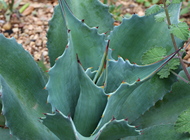 |
Eryngium — sea holly |
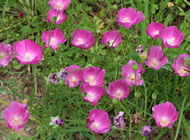 |
The genus
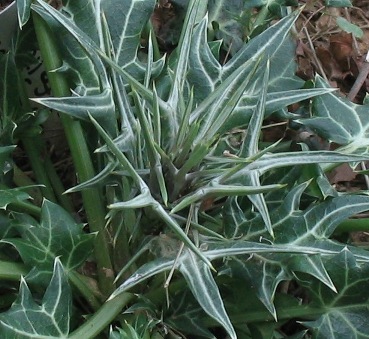
Eryngium — a genus of over two hundred herbaceous species,
including annuals, biennials, and long-lived perennials, distributed widely
around the world. They are classified in the umbellifer family (apiaceae), which they share with carrots,
masterworts, lovage, and quite a few other plants in our garden. One feature
shared by all members is smooth, hairless leaves.
The genus name is an ancient Greek word, which apparently alludes to the
plants' prickliness. I have not been able to track down a meaning. The most
common name encountered most to describe garden species is sea holly,
although that name does not apply to all species – logically, it only
refers to coastal species. Another common name is eryngo, which is
more suitably applied to grassland and other inland species.
Over the years, I've tried growing quite a number of eryngium varieties,
with greatly varying success. My first attempt was with E. planum, which
has been very tenacious indeed - its offspring, greatly multiplied, still
populates several areas of our garden. On the other hand, several species I've
unsuccessfully tried to start from seed, while a few successful attempts yielded
plants that proved to be short-lived in our garden. Still, it's one of my
hobby genuses, for which I harbor mild collector tendencies. Nothing too
extreme – I'm too stingy to pay much for plants, so almost all of my
attempts come from seed.
I'm writing this page because eryngium seldom bubbles to the top
of gardeners' plant lists (I know of no eryngium society), yet they're an
interesting bunch, worth a closer look. So here goes. This page will remain
rather tentative until next spring and summer, when I can take some updated
photos highlighting differences between the species.
Cultivation
As mentioned above, eryngiums differ greatly in their ease of cultivation.
Some, most notably E. planum and E. yuccifolium, are both
long-lived as individual plants and make plenty of seedlings, requiring
periodic removal. Both have strong taproots, are quite happy living in
heavy clay soil, and handle dry conditions with aplomb.
On the other side of the spectrum, there are the species I can just barely
keep alive. For example, I've started E. variifolium from seed several
times. On several occasions, they did not come through the winter; when
one finally did, it acted as a biennial, serving up flowers only once before
dying. The similarly silvery species E. bourgatii is somewhat longer-lived,
but still seems to fade away after a few years. As for E. agavifolium -
I find they are long-lived once firmly established (as long as good drainage
is provided), but can be hard to coax through their first year or two.
Notwithstanding obvious exceptions (for example, E. aquaticum), I
generally presume that the eryngiums in our garden need good drainage, as
well as full sun. For the most part, they don't require very fertile soil.
For evergreen species, such as E. agavifolium, take care not to mulch
too closely in winter.
My page only describes species that are hardy to our zone 6 garden. There
are some wonderful varieties that just won't work here, but so be it. I once
grew E. eburneum, which is probably hardy to zone 8. While it was still
alive after the first few freezes of the year, it did not come through its
first winter. Fortunately, there are still plenty of hardy kinds to try.
Propagation
Since most species grow from a single fleshy taproot, they are not easily
divided (or even transplanted); those with experience with root cuttings may
be successful at vegetative propagation (undertaken in late winter), but
I've limited myself to sexual methods - seeds!
My records don't include much comparative data for different germination
treatments: quite some time ago, I came to the conclusion that most species
germinate best with extended cold conditioning before germination at room
temperature, so that's my standard treatment. It works quite well for the
prolific species mentioned above - often, germination already starts during
the cold stage.
|
Some species resist most attempts to germinate. For example, E.
tripartitum has yet to germinate for me (which may reflect its possible
hybrid origin); I've given up trying. However, this is the one that responds
well to division. As for E. agavifolium,
I've collected seed from our garden many years, but only on one or two
occasions were my attempts to produce offspring successful. While this may
be due to sub-optimal germination conditions, I suspect that most of the
problem is the low viability of the seed. In fact, seed viability is
problematic for a good number of species - I've traded seed for several
varieties, but they mostly appeared to be duds. Good seeds have some bulk
– if you press down on them on a flat surface, they should not flatten.
That's easy enough to ascertain for species with larger seeds, but not so
straightforward for the smaller-seeded ones. So despite several attempts,
I've yet to establish E. foetidum or E. amethystinum. For the
kinds highlighted below, I've recorded detailed seed-starting records on the
individual portrait pages. |
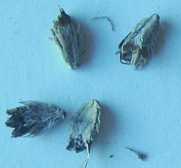
Seed for E. planum
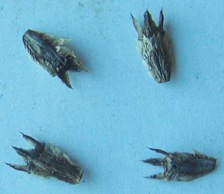
Seed for E. yuccifolium
|
A bevy of leaf shapes and colors
Some eryngiums have stunning foliage, others are just OK; some are evergreen,
others take a retreat in winter. The overview below showcases some of leaves,
as well as the growth habits of those that call our garden home.
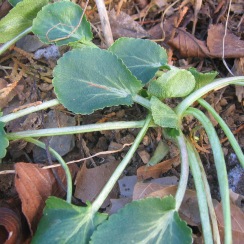 |
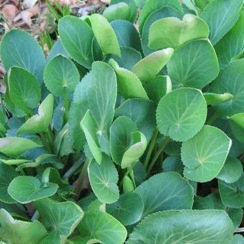 |
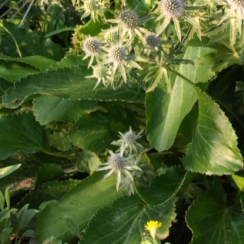 |
| Flat sea holly, E. planum, has deep green, fleshy, sometimes
shiny leaves, with a gentle serration. This photo, taken as the plant was
declining in December, isn't very typical of its appearance the rest of the
season. By late summer, the plants often flop, laying their fading flowerstalks
horizontally across whatever's nearby. |
E. tripartitum has superficially
similar leaves (it may be a hybrid involving E. planum as one of its parents),
but these are packed much more tightly together, somewhat smaller, and a lighter
color of bluish green. Also, the plants maintain a more upright habit, forgoing
the floppiness of E. planum. |
E. creticum continues in the same vein
with slightly serrated, leathery leaves, a bit larger and floppier than the
two first ones. A quick-growing species (this photo shows a first-year plant). |
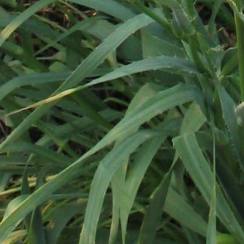 |
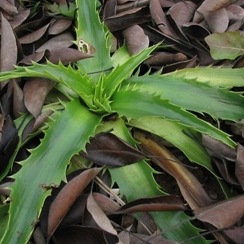 |
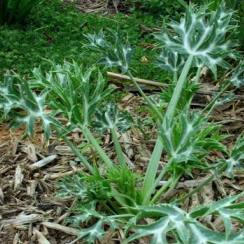 |
| E. yuccifolium's name refers to the
yucca-like leaves. Indeed they are similar: bluish-green straps, quite tough
and fibrous, with a bit of prickliness along the edges. They are lax, and
depending on the growing conditions and gardener's attention, can give the
plant a bit of a messy appearance. The common name for this species is
"Rattlesnake master", which refers to the use of its root by native
americans as an antidote to rattler bites. |
E. agavifolium is another one named for
its leaf shape, again quite appropriately. This plant is evergreen in our
garden; in fact, it shows off its shiny, grass-green leaves lined with stiff
spines most effectively in early winter. In early spring, the plants look a
bit bedraggled, until new growth kicks in. In this species, the leaves
definitely outshine the flowers. |
E. bourgatii is the first one we
acquired that has variegated foliage. The whole plant is smaller than others
we've grown, including the individual leaves, which are deeply cut, prickly
at the edges, and a rather pretty combination of silvery-white and dark
blue-green. |
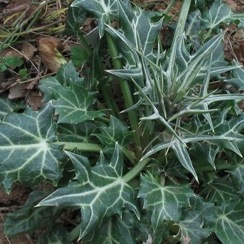 |
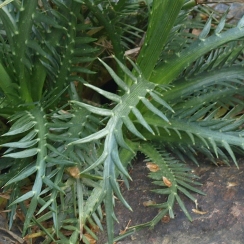 |
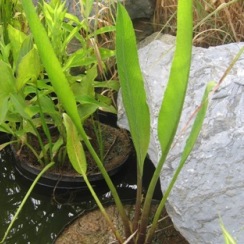 |
| Moroccan sea holly, E. variifolium,
lays on the contrast a little heavier: the green parts of the leaves are a
deeper hue, while the silvery veins, which in E. bourgatii blend softly into
the green, are quite distinct. Very striking – I wish I could keep the
plant alive. |
The latest addition to our Eryngium collection, E. venustum
has quickly become one of my favorites, mostly because of its marvellous
leaves. They are a bright bluish-green with an almost reptilian quality to
their arrangement of sharp-tipped leaflets along a central rib. Being
somewhat evergreen, they maintain an interest throughout the year.
|
Swamp eryngo, E. aquaticum, is the odd
one out in this bunch. As its botanical and common names imply, this plant
prefers a soggy position. The photo shows a first-year plant that showed
plenty of potential - fleshy red-tinged stalks holding slender, attractive
bright-green leaves. For reasons unknown to us, it didn't return for a
second year; we'll be trying this one again. |
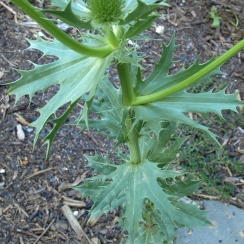 |
| As an annual, E. leavenworthii doesn't
have much use for a basal rosette of leaves - it carries most of its foliage
along its upright stalk. One of the prickliest-leaved eryngiums we grow. |
Flowers
The eryngiums that are grown for their flowers tend to be the ones
showing off steely-blue flowers and/or bracts, in the same vein as globe
thistles. Others have less eye-popping floral characteristics, although for
several the flowers still add pizzazz. Regardless of color, each of the ones
I've had the opportunity to harvest seeds from has prickly bracts! See the
table below for flower details.
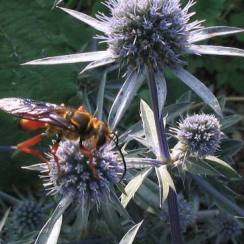 |
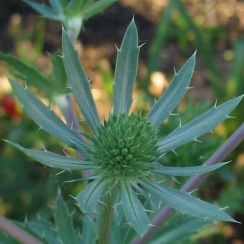 |
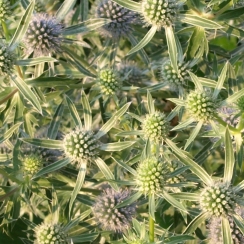 |
| E. planum is a member of the steely
blue clan, with fairly large flowers that are attractive to insects. |
E. tripartitum is similar, but its
flowers are smaller and more refined, especially the bracts. This photo was
taken before the blue color really came through. |
Like the first two, E. creticum sends up
branched stalks of many flowers that proceed from green through silvery to
blue - with different flowers on the same stalk undergoing the transition at
different times. I don't know if it's due to the inherent growth pattern of
this species or because ours are planted in richer soil, but the flowers on
this one seem to come more generously. |
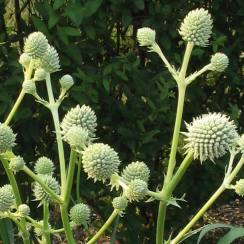 |
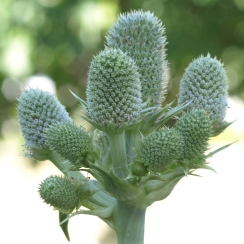 |
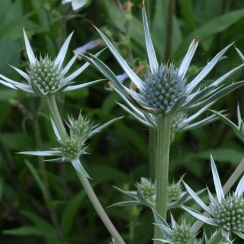 |
| E. yuccifolium's flowers are greenish-white
pompoms. They definitely add interest, but don't poke you in the eye about it.
|
In flower, E. agavifolium is
hardly a stunner.
Inflorescences are dull white, somewhat elongated, with several clustered
together on each flower
stalk. If it weren't for the fact that I like to collect some seed every year,
I would probably just lop the flower stalks off. |
E. bourgatii has smaller versions of the
blue flowers displayed by the first two in this table. In peak bloom, both
the leaves and the flowers combine to make a little gem of a plant. |
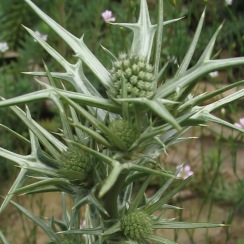 |
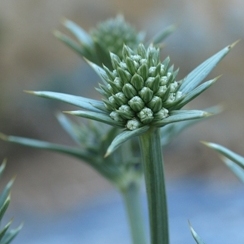 |
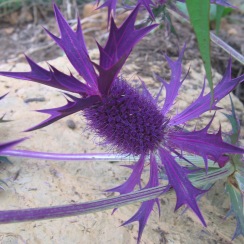 |
| E. variifolium sticks with the silver
theme: its flowers and spiny bracts don't do the blue thing, but extend the
silver from the leaf veining into the floral show. |
The flowers of E. venustum are in the greenish white camp,
but with their neat arrangement in a central leader with side stems, and the
crisp (and prickly) bracts surrounding pineapple-shaped flower clusters, I
find them to be more ornamental than some others in this color corner.
|
When you're a mere annual, you've got to have some stunning power to
make yourself attractive to picky gardeners. And sure enough,
E. leavenworthii plays the role admirably,
with royal deep purple flowers and bracts. The photo
here just shows the final stage - the stepwise coloration, proceeding through
various phases of green and lighter purple, is fun to watch.
|
Other species
Undoubtedly the most obvious omission from this page is E.
giganteum, a biennial with the same style of blue flower as E. planum
and tripartitum. An especially well-known cultivar is 'Miss Willmott's
Ghost', which has unusually pale bracts. It's still on my list of plants to
try, although its biennial nature is a negative, given that most others
highlighted on this page are fine perennials. Others on my to-try list,
some of which I've already tried unsuccessfully, are E. foetidum
(Mexican coriander), E. amethystinum (amethyst sea holly), E.
humile (a small rock garden species), E. alpinum, and E.
integrifolium (blueflower eryngo, a U.S. wildflower).
Then there's the tender ones that won't survive in our garden. Although
some are tempting, I'm not good at coddling plants through the winter,
especially if it involves lifting them and taking them indoors. Species in
this category include E. eburneum, E. pandanifolium, E.
proteiflorum, and E. ebracteatum.
Further reading
Wikipedia article
Visitors to this page have left the following comments| Linda | Dec 17, 2006 | My neice gave me one of these plants a couple of years ago, and it just bloomed this year. She didn't know it by any other name than sea holly. The book I have doesn't show the leaves with the flowers so It was hard to find which one it really was......until I happened upon this page and with the picture of the flowers and the foliage, I have been able to ID my plant as a E. Planum. So, thank you for showing both parts of the plants, so important for ID-ing plants.
I also love your idea of taking pictures of the plants in the spring as their popping through the ground. I've done a little, but will now do more. |
| sklenge | Apr 21, 2008 | Thanks for this. I've got a couple of seed heads that need growing. I'm not sure what type they are though so I'll report back on whether they grow and what they turn out to be. |
| Debbie Temple | May 07, 2008 | Firstly let me say that I found your page extremely helpful! Thank you. I have just started growing seeds this year, and have tried out Eryngium (for the purpose of cutting the flowers for my B&B). At the moment, I have a lot of seedlings come up that look like nettles......and I have no idea if they are supposed to be like that!!?? I think I have grown E. Alpinium. Can you offer any help?
Many thanks, Debbie
I wouldn't think eryngium seedlings could be easily mistaken for nettles. But to be sure, wait a while - eryngiums will have more rounded, thicker leaves than nettles. |
| Steven Cole | Jun 13, 2008 | I bought what I thought was an Eryngium Alpinum in May 2007 but discovered upon it's flowering that it was an Eryngium Planum. However, upon seeing your photographs the plant I have is actually an Eryngium tripartitum - the leaves and bracts are exactly the same. Many thanks for putting these photos up, Steven Cole. |
| Cleta Farrow | Mar 03, 2009 | Thank you for the information on E.levenworthii. I am thinking about ordering two of these to use in a garden as specimen plants. Are they sturdy and upright plants? Are they worthy of being considered as specimens? Thanks for any information you can share.
I would not describe them as sturdy and upright. In my moderate-fertility soil, they grow upward as young plants, but convolute and sprawl a bit by the time they get to blooming size. Which I find to be somewhat charming, but probably doesn't make for good specimen character in a more formal garden setting. I think they do better in a group. |
| Carole | Mar 16, 2009 | Very informative, thank you for your efforts. I considered ordering E. aquaticum but don't know if it could take my brackish water. |
| Stephen Russ | Oct 01, 2009 | Great page. Thanks. I bought an E. tripartitum on a whim and wanted to know more. Perfect. Great photos, too. I will explore your site more. Surely a work of love. Thanks. |
| frank | Mar 01, 2010 | After trying for 5 years to i have germinated Alpinum seeds.The seeds came from a plant in the museum gardens in York.I placed them in pots fresh from the plant last autumn and placed them outside.They were brought in to the greenhouse early last month and now find that i have about 200 seedlings and counting.They do need that cold snap to get them going
Hope this helps. Frank |
| mervyn | Sep 15, 2010 | I've grown both Eryngium campestre and E. bourgatii from seed by germination in the spring after storing seed over winter at room temperature. Eryngium planum germinates naturally in the garden (Zone 8 - 9)usually late August. It is necessary to keep the seedlings in compost which is damp at all times. I get better germination if the seeds are covered with 2mm sand. |
| jeff | Jun 19, 2011 | I am currently now growing 4 varieties of sea holly -- blue glitter, blue hobbit, saffire blue, and the alpine. I've noticed something funny that i have not read about anywhere... strange white bubble-like formations below the blooms? I have not touched them but when I blow on them they do seem to move like bubbles would.
Sounds like it may be a spittlebug infestation. I've not seen them on my sea hollies, though. |
| Kay | Jul 02, 2011 | I love the look of these plants, but I have amended clay soil and haven't had any luck growing them so far. Blue hobbit rotted out totally last Although it put up a stem with six flowers at the top, all the leaves have gone brown and fallen off from the bottom up and now the flowers are turning brown (and I was so hoping they would turn blue). Any suggestions?
Eryngiums haven't been terribly finnicky in my garden (which is also amended clay soil): E. planum, yuccifolium, and even agavifolium have been robust even through wet winters. Then again, I've lost some others, especially named varieties, so they may tend to be less tolerant of sub-ideal conditions. |
| Mike | Jul 18, 2011 | Hi Re odour of my sea holly. After searching underneath nearby plants for cat poo finally realized that this terrible smell was coming from my sea holly bracts. I didn't want to believe this so asked some visitors to our garage sale to try their noses closes to the bracts. It was the culprit. Just took out both 3 foot tall plants. It had swarms of bugs attracted too it. It was purchased as sea holly with no latin equivalent. I have grown it on the prairies, in central ontario and now in southern Ontario and had no trouble. It was a disappointment as it looked great. Someone suggested it was e. foetidum. It would be helpful if gardening books noted some of the negative characteristics of the plants.
I've not noticed this with any of my eryngiums – the E. foetidum theory seems plausible. I've tried to grow this species, but haven't ever been successful. Perhaps that's a good thing :-) |
| Mike M | Oct 02, 2011 | Very interesting webpage! I've being growing eryngiums with varying degrees of success since I first started gardening in 1997. I have many favourites, but do strongly recommend that you grow E. giganteum. The biennial nature of the plant I don't find a problem as if you let the seed heads ripen and the seeds fall, they will self seed, coming up in all sorts of interesting places. If unwanted they are easy to weed out. If you want it in a particular spot in the garden, just scatter some seed. It will often succeed in situ. I planted a couple of plants at least 10 years ago and each year I have some in flower and some seedlings growing on for the next year. All without any effort from me at all! The variety "Silver Ghost" is worth selecting as the bracts are of a silvery luminousity which look great in moonlight. E. giganteum also has the advantage of being stoutly upright without needing support. It is a showy, but self maintaining plant. Ideal for low effort gardeners like me!
Thanks Mike. I've finally managed to grow E. giganteum in recent years, just haven't gotten around to updating this page yet. Hoping to see 'Silver Ghost' in bloom next year. |
| Ann | Oct 25, 2011 | The eryngium with the bad odour of Mike could be a Eryngium Planum. I have the planum 'Blue glitter' and that has also a bad odour. |
| Karen Pitcher | Feb 29, 2012 | Thanks for the great information! A huge help with my assignment on identifying different cultivars! |
| jerry wehner | Apr 06, 2012 | ordered a double order from swallowtail seeds that should have arrived to them the first or second week of febuary,.....still waiting for my sea hollys. the spot for them in my garden is still bare, although the garlic "field" that I planted in november is doing great all 2'x4'. |
| jeff | Aug 22, 2012 | As we had a really really hot summer all of my sea holly blooms rotted this year really quickly.
Two other things I noted in their first full grow season:
1. the blue hobbit attracts lots of odd looking black flying ant type insects. the plants were COVERED with them during the daytime. I will be moving these plants away from my pool!
2. the alpine variety also attracted lots of the flies but also smelled REALLY awful for the majority of the summer. Will be taking that out too. It ended up being too tall for the place in the garden anyway.
3. lack of rain this year led to really short bloom life and lack of full colour. |
| Iain | Oct 07, 2012 | I have just retired and now have time for a garden neglected for 50 odd years. I can quite see how these sea hollies become a challenge. Out of 9 seeds I raised two up to three or four inches and planted them out in a rockery. They get more attention than the rest of my "alpines" put together. Fingers crossed they survive a Scottish winter. Your page is a good read and very helpful. |
| Kev | Oct 30, 2012 | Thanks for this. We bought a couple of plants from Strikes garden centre Burnmoor just before it closed down. I am looking at propagating from seeds. So thank you for the tips. |
| Ashley K. | Dec 19, 2012 | Hi Rob! I share your thistlephilia, as I call it. I've been working on a greener thumb, and finally got the nerve to buy my first eryngium planum seeds this fall. I recently fell in love with Eryngium supernova-- wow. A market near my home was selling them, and I almost wept with joy after months of near dead, withered E. Planum bouquets. They were breathtaking explosions of gigantic spring green and periwinkle seedheads, from a firework nest-burst of serrated spring green leaves. I bought them, of course, took photos, and searched the web for hours to discover the species. The only seed seller I could find was in Denmark, but they only shipped within the UK. I bought some anyway, and begged in the payment box for them to ship some here to Texas. For now, my question is this: the bouquet a bought from the market-- what are the chances that the seeds will mature, and what are the chances that they are viable? I don't know enough about the florist market or about gardening to guess whether or not there are seeds in a bouquet of cut erygiums, and if they are fertilized. I imagine a greenhouse somewhere, and no bees, and think they couldn't possible produce viable seeds. I'm hoping you in your wisdom could elucidate an ignorant Texan with an ungreen thumb? :-) Yours Sincerely, Ashley K.
I'm afraid I don't rate your chance of getting viable seeds from your bouquet very high. Not so much because of fertilization (although that may be an issue), but because the cut flower stems just can't provide the energy and nutrients required to create viable seeds. And eryngiums appear to be quite finnicky when it comes to setting seed: even in strong-growing plants, it appears that only a fraction of the seed particles are viable, with many more duds. Finally, your bouquet may well have come from a sterile hybrid (even though somebody sells the seeds, the fact that an awesome variety is not more widely available gives you pause, right?). In any case, best of luck getting your hands on some plants, by whatever means necessary :-) |
| Jennifer | Mar 31, 2013 | I am going to try growing these for the first time. I fell in love with this flower after finding it and asking my florist to include it in my wedding bouquet. They had never worked with it before but the results were absolutely beautiful. Thank you for the photos. I have been trying to match the photos to see what I had and think it might have been the E. Tripartitum. |
| Shirley | Jul 18, 2014 | With the help of your web site I have just found out that what I bought as a herb plant 2 years ago,and is now in flower is in fact E.tripartitum. Thanks. |
| marion | Jul 26, 2014 | My sea holly is massive and very beautiful but the awful smell ! it is also covered in fly's and bluebottles should carry a government health warning ! would be useful if the garden centre's and suppliers warned people especially if like me you have a small garden and can't escape the pong
Hmm, I've never noticed a foul odor to my sea hollies. Attracting insects of all kinds is usually a good thing, in my book :-) |
| Pete | Aug 11, 2014 | I just rec'd my order of ten Sea Holly seeds, and found your website as I was searching for germinating info, but after reading so many complaints of bad odors from these plants and the difficulty in germination, I'm already sorry I bought them. I can't imagine having a spot in the garden waiting for two years for seedlings to pop through the soil.
I've been very successful with lupines which are beautiful and super easy to grow. With them, germination is speedier if seeds are placed in the freezer for a few days first. Would this be beneficial for the Sea Holly seeds?
Should I germinate the Sea Hollys indoors or directly into garden or little cell pots or what?
Cool website, thanks.
I've not had any complaints about bad odors. Germination procedures will depend somewhat on the species, but for the most part, I find that a longish period of moist cold conditions is good to get them germinated (a few days in the freezer isn't going to do it). They will either germinate after a few months cold, or upon return to room temperature. Definitely start them indoors, especially if you have only 10 seeds. I use baggies for germination, but you can start them directly in cell packs, too. Baggies take up much less space in the fridge :-) |
| Natanya Piper | Sep 19, 2015 | Hello, I have enjoyed reading all the comments and wonderful information regarding Eryngium!! I just recently bought 10 seeds of Silver Ghost Sea Holly. I and in zone 6 and it is middle of September. Should I plant these directly in the soil now? Do I need to pre-chill them in the fridge for 3-4 weeks first? Or should I plant them directly in the soil early this coming spring? I was hoping to have blooms this next late spring. Is that an unreal expectation? I've read where they may take another year before blooms.
Chances are you'll have to wait another year to see the flowers. If you're impatient, it's possible that you may succeed by starting the seeds in ideal conditions now, so that they can grow to a meaningful size before winter cold arrives. They need the winter rest period before they will consider blooming. I don't know if there is enough time left in the year to get them to an overwinterable size. It sounds like you're intent on starting them directly outside, rather than inside under lights. If so, you can plant them after temperatures have come down in fall; they would germinate in spring. Many gardeners practice wintersowing, where they start their seeds in pots (better control than directly in the ground) left outside over the winter. That sounds like it might work for you. |
| Ann Mallonee | Jul 29, 2016 | I have tried three times to start my Eryngium seeds and finally have grown 6 small plants. Is it something I'm doing as to why it takes so long to start the seeds and then get them to grow once there up above the dirt? I started 50 seeds and most came up but then they died off slowly and this was in my green house.
I live in zone 9a and have plenty of dry sunny area to plant but my small plants seem to be thriving well in shade and a moist area in pots in my garden. Is all of this normal for sea holly? Also I have read two different ways to plant them and I want to make sure of the correct way, if you can help I would greatly appreciate it. |
| Filibert | Oct 10, 2016 | Eryngium maritimum and Eryngium campestre have edible roots that can be used as food the same as skirrit according to historical writings relating to Elizabeth Rainbow. The early leaf shoots are supposed to be edible similarly to Crambe maritimum. |
| Carl | Dec 19, 2016 | I searched for this page, because i have a large area of the plants flowering for the first time this season and also have the smell of cat pee in that area; on investigation i find the smell is coming from the sea holly E. planum flowers
I've never noticed much of a scent, pleasant or otherwise, from the sea hollies. But I'm not a fragrance gardener – my olfactory sense is sadly underdeveloped... |
| Katherine Couture | Jun 24, 2017 | Hello there,
Enjoy this site. I see Carl from Dec 19, 2016 left a note mentioning the smell of "cat pee". I cut my first year flowers several weeks ago to hopefully save the color from fading from my E.Creticum plant and came into the room finding some offensive odor, and couldn't figure what it was. Finally I picked up vase realizing that it coming from the plant. I placed it out in the patio and figured a few days out there my dissipate. It has not.
There are no animals in my backyard (it's fenced) and do not know what it could be. Is this normal?
Thank you for any information you can give me.
Although I haven't personally noticed it, it is quite possible that some eryngium varieties have a naturally unpleasant odor. In which case, they are probably best enjoyed outdoors :-)
|
| Laura Cox | Jul 22, 2017 | I've had one Eryngium for three or for years. It grows 2 to 3 feet high, with lovely blue purple flowers, even in my awful clay soil. It was only this year that we noticed the "poop" smell. It's horrible. I was sure the local raccoons had been using the flowerbed as a bathroom, but my 7 year old discovered it was the beautiful flowers. I'm sure it wasn't there before this year. Perhaps the plant changes with age, or climate. We had an abnormally cold winter (for Portland Oregon), and that has affected many of my plants. I won't take the plant out, as I enjoy its alien quality, but I try not to breath as I pass by it. |
| Merrall | May 30, 2018 | I was interested to read the comments regarding unpleasant odor in eryngium planum. I have 50 plants of e. Planum "blue glitter", and have not noticed any unpleasant odor, only a slight celery like smell when i strip the folliage. I wonder if it might have to do with climate. I am in dunedin, nz, which is usually very temperate, cool days and cold nights, though this last summer was unusually warm and dry, with several days at 30 centigrade. |
| Brian | Aug 05, 2018 | On the subject of bad smelling eryngiums I can vouch for the fact that E. varifolium smells simply appalling - at least mine does. A bit like the smell that washing takes on thanks to bacterial proliferation if it stays damp too long in humid conditions. Haven't noticed a problem with any of the others (planum, bourgatii, x zabellii, giganteum). Anyway, thank you so much, Rob, for this terrific site. It's a splendid resource for gardeners, and I really appreciate all the time and effort you have put into it. |
| Matt | Jul 13, 2019 | This is the type of resource I’ve been looking for! Thanks!
So I’m in 4b approximately and we have yuccifolium natively south of here! And it turns out that’s what I have after finally germinating them last year and them surviving a Minnesota winter. I was trying to buy electric blue ones the seller marketed as planum.
Never fear I have one of my expensive nursery planum big blue varieties still alive in a pot I brought inside but it just doesn’t really grow or bloom. I just feel such a connection to this type of plant somehow and will be very sad if I don’t get some electric colors. Leavenworthii looks like it’s amazing.
Yeah, I love leavenworthii. Haven't grown it in many years - it's hard to find. But I'd like to try again now that I garden in Texas. Good luck with your planum! |
| Joseph Cleave | Oct 09, 2020 | Hello I stumbled on your knowledgeable web page while trying to research 2 recent Eryngiums I’ve purchased (yuccifolium) & (agavifolium).
I’ve grown I high interest in Eryngiums as I’ve had a very successful growth of our E.Planum, I’ve sown these from their seed last winter and planting them out as they got to big for the 3L pots they was in(deep roots!).
I’ve also got E.Variifolium amd grown well and plan to sow those seeds too.(I love the silver of this 1)
I’ve also collected seeds of E.Gigantium miss Willmotts ghost and plan to sow this also.
After reading your knowledgeable page You’ve encouraged me to try the annual variety.
What I love about Eryngiums is not only do pollinators love them but almost all varieties have different foliage and even visibly makes them look like different plants altogether, you could have a garden full of different varieties unknowingly to visitors that they are all Eryngiums.
Sorry to waffle on, thank you.
J Cleave from Gloucester - UK |
I welcome comments about my web pages; feel free to use the form below to
leave feedback about this particular page. For the benefit of other visitors
to these pages, I will list any relevant comments you leave, and if
appropriate, I will update my page to correct mis-information.
Note that I discard any comments including
html markups, so please submit your comment as plain text. If you have a
comment about the website as a whole, please leave it in my
guestbook. If you
have a question that needs a personal response, please
e-mail me.
Last modified:
June 03, 2012
Contact me
|























